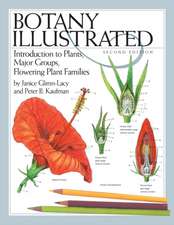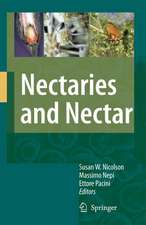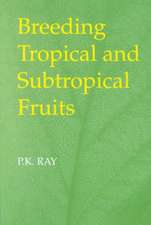Proceedings of the Second International Oats Conference: The University College of Wales, Welsh Plant Breeding Station, Aberystwyth, U.K. July 15–18, 1985: World Crops: Production, Utilization and Description, cartea 12
Editat de D.A. Lawes, H. Thomasen Limba Engleză Paperback – 13 oct 2011
Preț: 377.45 lei
Nou
Puncte Express: 566
Preț estimativ în valută:
72.23€ • 75.97$ • 60.35£
72.23€ • 75.97$ • 60.35£
Carte tipărită la comandă
Livrare economică 08-22 ianuarie 25
Preluare comenzi: 021 569.72.76
Specificații
ISBN-13: 9789401084611
ISBN-10: 9401084610
Pagini: 304
Ilustrații: 303 p.
Dimensiuni: 155 x 235 x 16 mm
Greutate: 0.43 kg
Ediția:Softcover reprint of the original 1st ed. 1986
Editura: SPRINGER NETHERLANDS
Colecția Springer
Seria World Crops: Production, Utilization and Description
Locul publicării:Dordrecht, Netherlands
ISBN-10: 9401084610
Pagini: 304
Ilustrații: 303 p.
Dimensiuni: 155 x 235 x 16 mm
Greutate: 0.43 kg
Ediția:Softcover reprint of the original 1st ed. 1986
Editura: SPRINGER NETHERLANDS
Colecția Springer
Seria World Crops: Production, Utilization and Description
Locul publicării:Dordrecht, Netherlands
Public țintă
ResearchCuprins
Opening of Conference.- Opening of Conference and Welcome to Delegates.- Session I: Genetic Resources and their Use in the Breeding of Oats.- Genetic resources and their use in oat breeding.- The use of disomic alien addition lines in the transfer of oat stem rust resistance to hexaploid oats.- Introgression of diploid wild Avena species into Avena sativa.- Interspecific hybrids in Avena.- Tissue culture induced variation in oats.- Phylogenetic relationships between Avena species revealed by the restriction endonuclease analysis of chloroplast and mitochondrial DNAs.- Molecular biology of oat storage protein genes: probes for evaluating germplasm variation.- Callus induction and plant regeneration from oat cultivars.- Differentiation of spikelet type in Avena in relation to the ploidy.- The identification of Avena chromosomes by means of C-banding.- Session I: Chairman’s comments and summing up.- Session II: Pests and Diseases of Oats.- Diseases of Oats.- Pathogenicity of crown rust, stem rust and powdery mildew on oats in Europe and sources of resistance.- Adequate rust resistance in oats.- Genetic analysis of crown rust resistance and phytoalexin production in oats.- Variation and distribution of the oat crown rust fungus, Puccinia coronata avenae, in Britain in relation to breeding resistant oat cultivars.- Transgressive segregation for increased levels of adult plant resistance to mildew in oats.- The nature of horizontal resistance of oats to crown rust.- Resistance and tolerance in oats, Avena spp. to the cereal cyst nematode, Heterodera avenae.- Transmission of barley yellow dwarf virus isolates by the aphid Rhopalosiphum insertum (Walker).- Oat crown rust (Puccinia coronata avenae) races identified in the West Region of the USSR.- Session II: Chairman’scomments and summing up.- Session III: Efficiences of Breeding Methods For Oats.- Development of oat breeding methods.- Inheritance of primary: secondary seed weight ratios and secondary seed weight in oats.- Stability of German oat cultivars (Avena sativa L.): special consideration is given to non-typical oat florets.- Mass (gravimetric) selection in diseased nurseries.- Mass selection for improved milling performance.- Present status of research to develop useful semi dwarf oat germplasm.- Hybridising of oats utilising chemical hybridising agents.- Breeding winter oats - special considerations.- Pedigree of German oat cultivars and their identification by isoelectric focusing.- Session IV: Crop Physiology and Production Methods of Oats.- Crop physiological approaches to increased productivity in oats.- Some metabolic constraints to oat productivity.- Effects of genotype, seeding rate and grain yield components on the primary: secondary seed weight ratio in oats.- Breeding oats by selection of parental pairs from different ecological and geographical backgrounds.- The tolerance of oat varieties to Hoegrass (375 g/l diclofop-methyl).- The chemical control of wild oats in oats - a progress report.- Effects of herbicides on oats.- Improving winter hardiness in winter oats by seed treatment with PGRS.- Winter oat husbandry - results from ADAS trials 1982–84.- Session IV. Chairman’s comments and summing up.- Session V: Quality, Use and Marketing Requirements for Oats.- World oats use and marketing.- Oat quality - present status and future prospects.- Oil and protein content in oats (Avena sativa L.).- Influence of fertiliser use on the quantity and composition of oil in oats.- Quality in oat breeding - a question of priorities.- Effect of lemma colour on grain qualityin oats, Avena sativa L..- Prospects for the naked oat crop in the UK and its agronomy, with particular reference to the spring oat cultivar Rhiannon.- Hull-less oats for the milling industry.- Oats - the health story.- Session V. Chairman’s comments and summing up.- Session VI: World Status of Oats and Biological Constraints to Increased Production.- World status of oats and biological constraints to increased production.- Oat breeding at the University of Passo Fundo, Brazil, 1976–1984.- Oat production and breeding in Ijuí, RS, Brazil.- Performance of oats in the Quaker - South American Nursery 1983–84.- Selecting oats for North Island conditions: collaboration between New Zealand and Canada.- Oat breeding research at Pantnagar - India.- Oat breeding in the USSR and the initial breeding material.- Oat breeding and production in Hungary.- The oat crop in the UK.- Session VI. Chairman’s comments and summing up.- Author Index.- List of participants.
























